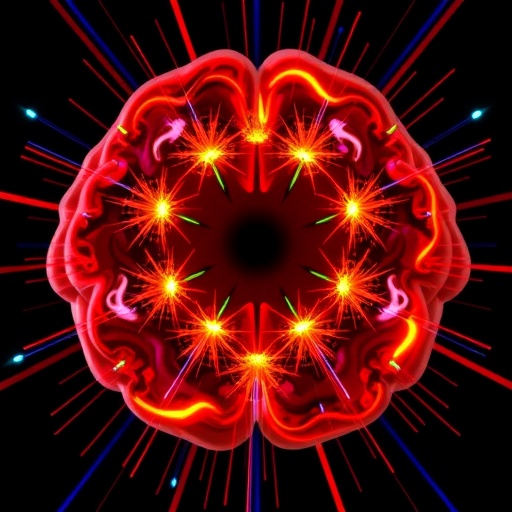In a groundbreaking advancement at the intersection of photonics and biological imaging, researchers have successfully leveraged a novel multifocal metalens-based image scanning microscopy technique to transcend conventional diffraction limits in the imaging of brain organoids. This pioneering approach, detailed in a recent publication in Light: Science & Applications, represents a significant leap forward in the resolution and clarity achievable for studying the intricate three-dimensional structures of brain organoids, which are critical models for understanding neurodevelopment and neurological disorders.
Brain organoids, miniature and simplified versions of the brain cultivated in vitro from stem cells, have rapidly become indispensable tools for biomedical research. Yet, their densely packed and complex cellular architecture demands imaging systems capable of revealing ultrastructural details far beyond the limits imposed by traditional optical microscopy. Conventional methods often fall short in resolving fine details within these organoids, limiting observations to relatively lower resolution planes and thereby constraining the biological insights that researchers can gain.
The research team, composed of Yi Jo, Hyun Park, Seo Lee, and colleagues, has innovatively integrated the concept of image scanning microscopy (ISM) with the emerging technology of metalenses—ultrathin, nanostructured lenses engineered to precisely control light propagation at the subwavelength scale. Unlike conventional glass lenses, metalenses can be designed with multiple focal points, allowing simultaneous scanning of several depths within a sample, drastically enhancing imaging throughput while maintaining exceptional resolution.
Central to this achievement is the fabrication of a multifocal metalens capable of generating a pattern of focused light spots across the sample. By coupling this with a highly sensitive detector and sophisticated scanning algorithms, the system reconstructs images with spatial resolutions surpassing the classical diffraction limit—a feat that unlocks visualization of previously inaccessible subcellular features within brain organoids.
The implications of this work extend beyond mere technical curiosity. High-resolution, volumetric imaging of brain organoids can accelerate the understanding of neural circuitry formation, synaptic connectivity, and pathological alterations associated with diseases such as Alzheimer’s, epilepsy, and autism spectrum disorders. Enhanced imaging clarity also facilitates drug screening and therapeutic interventions by enabling precise monitoring of cellular responses in three dimensions.
Technically, the multifocal metalens in this system is engineered using nanophotonic principles, where arrays of microscopic pillars or nanoantennas are etched onto a substrate to manipulate phase, amplitude, and polarization of incident light. This precise nanofabrication allows tailoring of the metalens’ optical response to create multiple tightly focused spots of light distributed laterally and axially, enabling parallel scanning.
Image scanning microscopy traditionally involves scanning a focused laser beam across a fluorescent sample and detecting emitted light to construct an image. Through the multifocal metalens, multiple excitation points are scanned concurrently, significantly reducing imaging time while improving signal-to-noise ratios, thanks to the reduced excitation power per focal point avoiding photodamage to sensitive biological samples.
Moreover, this optical configuration seamlessly integrates into existing microscopy platforms due to the planar and compact nature of the metalenses, eliminating bulk optics and enabling the miniaturization of super-resolution microscopes. This accessibility opens doors for widespread adoption in various laboratories, promoting advances in biomedical research worldwide.
The optimization process described involves fine-tuning the metalens design to balance focal spot size, depth of field, and intensity uniformity across multiple focus points. This ensures that all regions of the brain organoid are illuminated and imaged with consistent resolution and contrast, crucial for the quantitative analysis of intricate biological features.
Furthermore, the authors demonstrate the successful application of their system by imaging brain organoids stained with fluorescent markers highlighting distinct cellular compartments, revealing unprecedented levels of detail within their complex microenvironment. The sub-diffraction-limit imaging capability enabled visualization of dendritic spines and fine neuronal processes, structures essential for understanding neural communication pathways.
The integration of computational post-processing algorithms further enhances image reconstruction, compensating for aberrations and extracting meaningful data from raw fluorescence signals. This synergy of hardware innovation and software sophistication is a hallmark of modern super-resolution microscopy developments.
In addition to its biological applications, the technology holds promise for diverse fields requiring nondestructive, high-resolution optical imaging, including materials science, nanotechnology, and live-cell imaging, potentially revolutionizing microscopic examination protocols across disciplines.
Challenges remain, including scaling the production of such intricate metalenses and integrating them into commercial instruments, but the demonstrated proof-of-concept underscores a robust framework upon which future innovations can expand. Collaborative efforts between physicists, engineers, and biologists are anticipated to push this technology toward clinical translations, particularly for diagnostics and therapeutic monitoring at the micro and nanoscale.
Ultimately, the work of Jo and colleagues illuminates a path toward overcoming longstanding barriers in optical resolution, offering a powerful, versatile, and efficient imaging tool that promises to deepen our understanding of brain development, function, and disease with unprecedented fidelity. As brain organoid research continues to evolve, this multifocal metalens-based ISM methodology will likely become an indispensable asset in the neuroscientist’s toolkit.
Subject of Research: Optical imaging advancements for sub-diffraction-limited visualization of brain organoids using multifocal metalens-based image scanning microscopy.
Article Title: Image scanning microscopy based on multifocal metalens for sub-diffraction-limited imaging of brain organoids.
Article References:
Jo, Y., Park, H., Lee, S. et al. Image scanning microscopy based on multifocal metalens for sub-diffraction-limited imaging of brain organoids. Light Sci Appl 14, 367 (2025). https://doi.org/10.1038/s41377-025-01900-3
Image Credits: AI Generated
DOI: https://doi.org/10.1038/s41377-025-01900-3
Tags: advancements in photonicsbiomedical research toolsbrain organoids imagingbrain structure analysishigh-resolution imaging systemsimage scanning microscopy innovationsmultifocal metalens technologyoptical microscopy limitationsresolution in biological imagingstudying neurodevelopmental disorderssub-diffraction imaging techniquesultrathin nanostructured lenses





